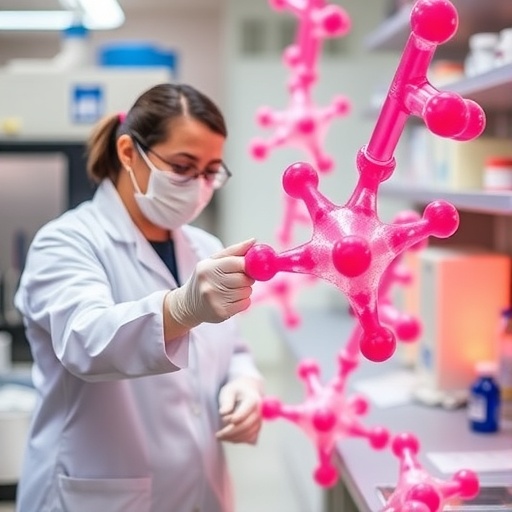In a groundbreaking development destined to reshape diabetes treatment paradigms, scientists from the University at Albany and the NYU Grossman School of Medicine have unraveled a critical molecular mechanism fueling chronic inflammation and defective wound repair in diabetic patients. This novel discovery, recently featured on the cover of Cell Chemical Biology, centers on disrupting a pivotal intracellular signaling cascade that exacerbates diabetes complications, offering fresh hope for therapeutic intervention that targets the disease’s root causes rather than merely managing symptoms.
For decades, the medical community’s approach to diabetes has largely focused on controlling hyperglycemia through various pharmacological and lifestyle strategies. However, persistent inflammation remains a formidable challenge, silently advancing tissue damage and fostering cardiovascular complications and poor wound healing in afflicted individuals. The new research ventures beyond glucose management, spotlighting a molecular antagonist, denoted as RAGE406R, capable of selectively impeding a cellular receptor pathway that drives such deleterious inflammatory responses.
The crux of the pathological process involves advanced glycation end products (AGEs), molecules that accumulate in the tissues of individuals with diabetes due to prolonged high blood sugar levels. These AGEs activate the Receptor for Advanced Glycation End Products (RAGE), an essential cell surface sensor that transmits stress signals inside cells. Upon activation, RAGE interacts with DIAPH1, a formin protein ordinarily involved in maintaining cell structure and movement. Yet, when stimulated in excess by RAGE, DIAPH1 initiates a cascade resulting in sustained inflammation, significantly contributing to diabetic morbidities.
Leveraging cutting-edge structural biology tools, the investigative team meticulously constructed a detailed molecular model portraying the interface at which the RAGE receptor binds DIAPH1. This breakthrough allowed identification of a precise binding site on DIAPH1, a discovery instrumental in guiding the design of RAGE406R. This small molecule works by occupying the critical site on the receptor usually reserved for DIAPH1 binding, thereby obstructing the signaling pathway responsible for inflammation perpetuation.
The discovery process was marked by comprehensive screening of over one hundred compounds. Using sophisticated Nuclear Magnetic Resonance (NMR) spectroscopy alongside fluorescence analyses, the researchers isolated RAGE406R for its exceptional binding affinity and inhibitory action. This dual-method approach ensured the molecule’s specificity and potency in neutralizing RAGE-DIAPH1 signaling, a feat previously unattainable due to the complexity of intracellular interactions.
Fundamentally, RAGE406R’s mechanism halts the propagation of pro-inflammatory messages at their inception by sterically hindering DIAPH1’s association with RAGE. This blockade presents a paradigm shift by directly targeting the intracellular machinery fueling chronic inflammation, potentially curtailing the progression of diabetes complications that standard glycemic control therapies do not address.
Experimental validation of RAGE406R’s efficacy revealed promising outcomes both in vitro and in vivo. In human macrophage cells harvested from individuals living with type 1 diabetes, treatment with the molecule significantly diminished the expression of key inflammatory cytokines. This reduction signals the drug’s capacity to modulate immune cell behavior, altering the inflammatory milieu that often exacerbates diabetic pathology.
Animal studies reinforced these findings, with diabetic mice exhibiting accelerated wound healing and marked attenuation of inflammatory markers following RAGE406R administration. These in vivo successes underscore the molecule’s translational potential, laying groundwork for future clinical trials aimed at assessing safety, dosage, and efficacy in human subjects.
Critically, the unique approach of RAGE406R in targeting the ignition point of inflammation implies therapeutic benefits for both type 1 and type 2 diabetes, addressing a longstanding gap in treatment options. By divergence from glucose-centric strategies, this novel agent might reduce the burden of diabetic complications—cardiovascular disease, neuropathy, retinopathy—that collectively impair patient quality of life.
The researchers plan to extend their work by employing advanced in-cell NMR techniques alongside classical molecular biology methods to further dissect the pathway modulated by RAGE and DIAPH1. A deeper understanding of this mechanism will refine drug development, inform biomarker discovery for clinical monitoring, and potentially illuminate additional therapeutic targets within the inflammatory cascade.
Furthermore, interdisciplinary collaborations with clinical teams are underway to shepherd RAGE406R through the translational pipeline. These partnerships aim to accelerate the progression from promising laboratory findings to viable, market-ready treatments that may revolutionize diabetes care worldwide.
Current diabetes pharmaceuticals primarily cater to type 2 diabetes, often leaving type 1 patients with limited options beyond insulin therapy. RAGE406R’s broad mechanism opens the door for innovative treatments applicable across the diabetes spectrum, a leap that could significantly reduce morbidity and healthcare costs associated with this chronic disease.
The implications of this research transcend diabetes alone, offering insights into inflammatory processes that underpin numerous other diseases. By illuminating the molecular interplay between cellular receptors and downstream effectors, the study paves pathways for future drug discovery in diverse medical fields where inflammation is a core pathological element.
As the prevalence of diabetes continues to rise globally, innovations such as RAGE406R provide critical momentum toward therapies that don’t just mitigate symptoms but fundamentally alter disease trajectories. This transformative research exemplifies the power of integrative science to challenge existing medical dogma and forge new frontiers in patient care.
Subject of Research: Animals
Article Title: RAGE-mediated activation of the formin DIAPH1 and human macrophage inflammation are inhibited by a small molecule antagonist
News Publication Date: 29-Oct-2025
Web References:
Cell Chemical Biology Article
CDC Diabetes Data
References:
DOI: 10.1016/j.chembiol
Keywords:
Diabetes, Chronic inflammation, Drug development, Wound healing




